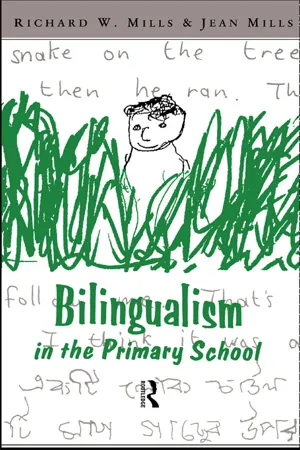Chapter 3
Monolingual teachers assessing bilingual children
Jean Mills
EDITORS’ INTRODUCTION
This chapter serves as a general introduction to those which follow and which focus on specific situations. Any assessment is problematic and one could develop this declension by saying: assessment is difficult; oral assessment is very difficult; bilingual assessment is extremely difficult.
The term ‘assessment’ itself requires definition. Do we mean assessment of abilities, such as maths concepts, by using mother tongue? Or do we mean, the assessment of an individual’s language skills in English and in mother tongue? Whichever aspect is chosen, it is still important to examine the basic premises that underlie any assessment, namely, what is ‘good practice’ in this area? Obviously, in assessing bilingual children, the same issues will occur, but there will be the added complications of cultural relevance; the influence of particular contexts; the nature of children’s abilities in their different languages.
Comfort is offered to teachers who do not share the languages of the children they teach. (Such teachers, of course, may, or may not, be monolingual.) Again, the recommendation is ‘back to basics’, i.e. to call upon those skills of observation and reflection in which most professionals are already adept. Teachers may then note, as part of formative assessment, children’s development of language-learning strategies and, in particular, their knowledge about language (KAL). Assessment in these terms ultimately rests on the collection, and interpretation, of apparently chance remarks in a range of situations. As the examples suggest, reflection on such instances increases a teacher’s ability to develop insight into children’s language repertoire.
Without bilingual skills, teachers are trying to find the best highjumper by seeing who’s good at running.
(Monolingual teacher)
How do we, as primary school teachers, assess oral language? Do we use tick-off categories on checklists? Do we analyse transcripts of tape recordings? Do we monitor with ongoing judgements as the spoken language is uttered? Perhaps we use combinations of all these, but experience over the past twenty years indicates just how difficult the task is. (See Appendices 3 and 4).
Even the Assessment of Performance Unit (APU) surveys during the 1980s, using a fairly structured technique, only attempted to assess 11- year-olds in the primary range, and then within a circumscribed set of categories (viz. Instructing/Directing, Giving and Interpreting Information, Narrating, Describing, Discussing). How much more difficult it is to achieve anything comprehensive across the age and ability range, when children in the same class speak two or three different languages.
This chapter lays down the premises for the case studies which follow.
It attempts to give a conceptual framework to the more detailed and specific discussion in those chapters.
Where, then, can bilingual assessment begin if, by that, we mean:
- the assessment of specific abilities (such as maths or history concepts)through mother tongue; and
- the more general assessment of a child's linguistic abilities in English and mother tongue?
It begins from the same fundamental premises that good practice for monolingual children should also be good practice for bilingual children, and that basic assessment procedures will be the same for both groups, albeit with different emphases.
Here, then, are some general criteria which apply as much to multilingual, as to monolingual, classrooms.
(a) A good language classroom supports all the languages, varieties and dialects which are spoken in it.
Thus, it may be appropriate for children to compare their local dialect with standard English (as the National Curriculum requires, see AT1, Level 5, e; 6, d); to write explanations of dialect words; to carry out role play in dialect and standard English.
Similarly, children who can write in scripts other than English can use these skills in any investigation of the history of writing and of alphabets.
Likewise in spoken language where, as the Cox Report indicates, the experience of language of bilingual children is ‘greater than that of their monoglot peers’ and provides ‘a focus for discussion about language forms’ (1988:58).
b) Assessment of standard English is only one dimension of a child’s all-round language abilities. Some children have a very wide linguistic repertoire, made up of several language varieties. The very term ‘bilingual’ (see the Introduction and Baetens Beardsmore 1986: Chapter 1) may obscure this, sin...
